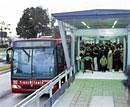

There is no dearth of buses for the City. However, the roads are so congested that buses have to vie for space with other vehicles. Getting into a bus alone can be a daunting task, in the absence of bus bays.
Bangalore City, which boasts of many firsts, has failed to go in for Bus Rapid Transit System (BRTS). Often, policy makers propose this system though there are no concerted efforts to prepare the roads for adopting this transit mode. BRTS has been successfully adopted in Ahmedabad, Delhi and Pune.
For the last 10 years, many officers of the Transport Department have gone abroad to study the merits of BRTS. However, so far, the visits have not influenced the government enough to have the system in place.
BRTS is an effective bus-based transit system in cities. All it needs is dedicated lanes for the movement of buses meant for public transport.
Such a system naturally allows high frequency of bus service and efficient ticketing system. It offers both safer and environment-friendly service. Because the lane is dedicated, chances of accidents are minimal. The commuters can reach the destinations without hiccups.
JnNURM, a national mission to improve urban infrastructure facilities, proposed to fund the buses meant for city services or BRTS. BMTC opted to make use of the Mission for city services. Sadly, it did not show interest to take up BRTS under the JnNURM. The Mission approved the BMTC’s proposal to procure 1,000 low-floor buses for urban transport at a cost of Rs 303.07 crore.
There are several reasons for this shortsighted planning. But the authorities concerned blame the narrow roads of the City for not being able to provide comfortable and highly economical mode of transport for the citizens. BMTC MD Syed Zameer Pasha says, “Any fresh concept needs time for implementation. Roads in Bangalore do not belong to BMTC.
Now, BDA and BMTC are jointly making efforts for bringing in BRTS on the road connecting to Bengaluru International Airport.”
BRTS is considered the best system for public transport worldwide. Curitiba in Brazil, is one of the first cities to have the system in the 1970s. Bogota, the capital of Colombia, has one of the best BRT Systems, commissioned in 2002.
Passengers do not wait for more than three minutes to catch a bus to their destinations. Bogota chose BRTS against metro. Traffic experts worldover visit these places to study the system.
Many experts and officers from Bangalore have visited these cities to study the system.
In India, Ahmedabad, Delhi and Pune have implemented this mode of public transport.
The Gujarat government has named the system in Ahmedabad - Janmarg BRTS - to popularise it as people’s route. The system includes electronic fare collection, well-planned terminals, junctions and stations. The facility was introduced in 2009.
In Bangalore
Prof M N Sreehari, traffic engineering adviser, said Bangalore should have implemented BRTS long ago. He argued that 60 percent of Bangalore’s roads are narrow and BRTS could be introduced only on wide roads which allow two way transport.
Bangalore city planners have been contemplating this system for more than a decade now. It was first mooted during the regime of S M Krishna.
The then transport minister Ramanath Rai had assured the public of easing the traffic problem by adopting BRTS.
It was proposed to connect Silk Board Junction and Hebbal flyover via Marathhalli along the Ring Road. Covering a distance of 30 kms, it was aimed at minimising the duration to reach Bengaluru International Airport.
Sreehari had done a feasibility study on the proposed BRTS connecting Silk Board junction and Hebbal flyover. BMTC and BDA are holding consultations to widen the ring road for putting a successful BRTS in place. “There will be dedicated lanes for buses on either directions. I hope this will be a reality in the next two years,” Pasha said.
What is BRTS?
Bus rapid transit system is an effective public transit mode with dedicated lanes for buses. This offers better service for passengers as they do not encounter traffic congestion. It consists of an advanced collection mode and ample number of buses so that passengers need not wait for long in the stations.
What it requires?
* Dedicated lanes of a width of at least 3.5 metres in either direction
* No entry for private vehicles to the dedicated lane
* Dedicated roads meant for buses, ambulances, police vehicles
* Easy access to bus stations
* Advanced fare collection mode
* Ample number of buses to offer frequent service